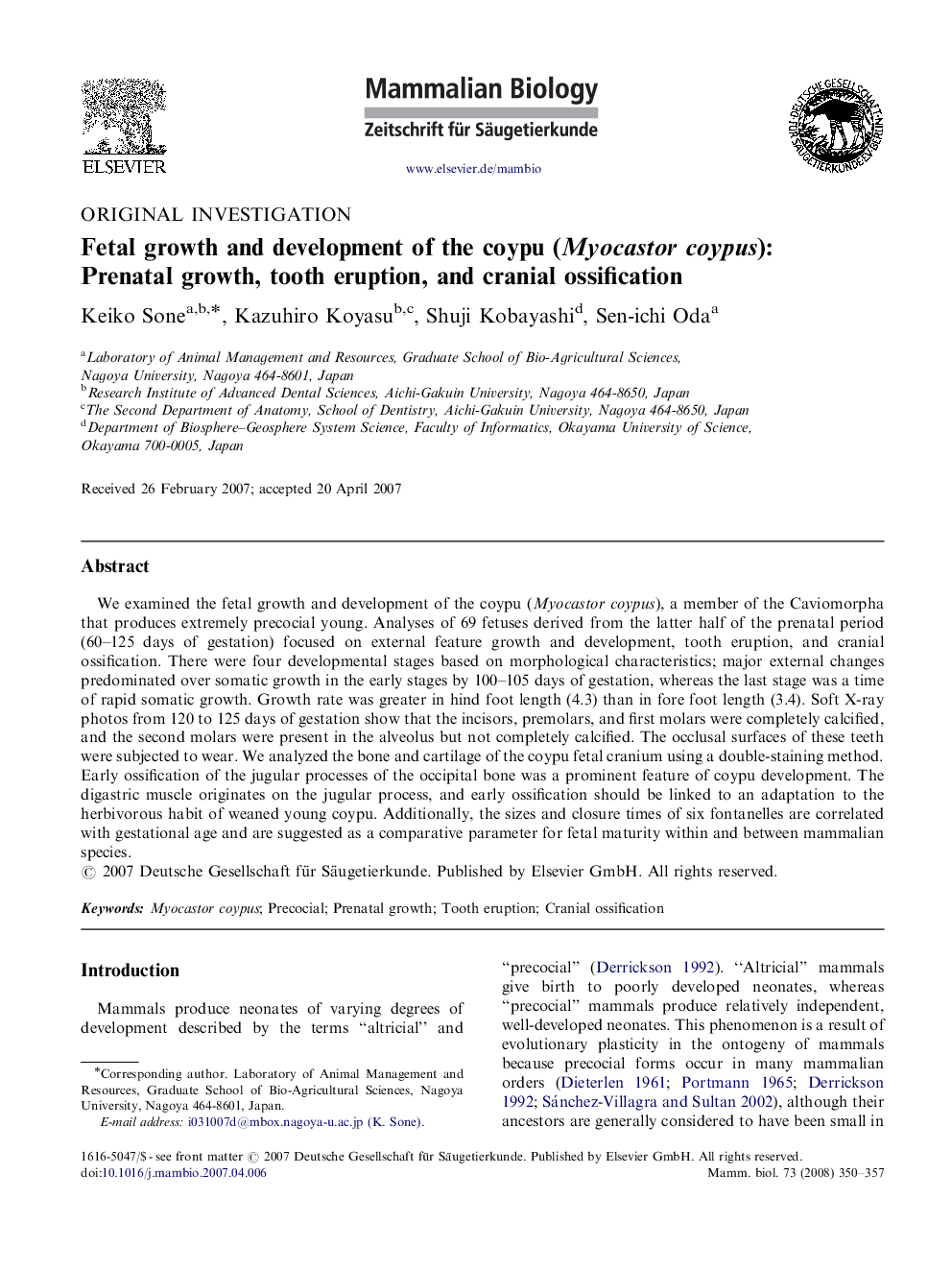| کد مقاله | کد نشریه | سال انتشار | مقاله انگلیسی | نسخه تمام متن |
|---|---|---|---|---|
| 2193952 | 1098409 | 2008 | 8 صفحه PDF | دانلود رایگان |

We examined the fetal growth and development of the coypu (Myocastor coypus), a member of the Caviomorpha that produces extremely precocial young. Analyses of 69 fetuses derived from the latter half of the prenatal period (60–125 days of gestation) focused on external feature growth and development, tooth eruption, and cranial ossification. There were four developmental stages based on morphological characteristics; major external changes predominated over somatic growth in the early stages by 100–105 days of gestation, whereas the last stage was a time of rapid somatic growth. Growth rate was greater in hind foot length (4.3) than in fore foot length (3.4). Soft X-ray photos from 120 to 125 days of gestation show that the incisors, premolars, and first molars were completely calcified, and the second molars were present in the alveolus but not completely calcified. The occlusal surfaces of these teeth were subjected to wear. We analyzed the bone and cartilage of the coypu fetal cranium using a double-staining method. Early ossification of the jugular processes of the occipital bone was a prominent feature of coypu development. The digastric muscle originates on the jugular process, and early ossification should be linked to an adaptation to the herbivorous habit of weaned young coypu. Additionally, the sizes and closure times of six fontanelles are correlated with gestational age and are suggested as a comparative parameter for fetal maturity within and between mammalian species.
ZusammenfassungEs wurden 69 Nutriaföten aus der zweiten Hälfte der pränatal Periode (60.-125. Tag) untersucht. Die Art ist bekannt für die Geburt sehr frühreifer Jungtiere. Morphologisch konnten vier Entwicklungsabschnitte unterschieden werden. Äußere Veränderungen waren zwischen dem 100. und 105. Tag dominierend, wogegen im letzten Abschnitt ein rapides somatisches Wachstum stattfand. Die Wachstumsrate der Hinterfußlänge (4.3) war größer als diejenige der Vorderfußläng (3.4). Röntgenaufnahmen zeigten, daß nach 120–125 Tagen die Incisiven, Prämolaren sowie die ersten Molaren komplett kalzifiziert waren. Die zweiten Molaren waren in den Alveolen vorhanden, jedoch noch nicht vollständig kalzifiziert. Die Okklusionsfläche zeigte Abnutzungsspuren. Die Schädelverknöcherung wies vor allem eine frühe Ossifikation des Jugularfortsatzes des Petrosum auf. Der Musculus digastricus nimmt hier seinen Ursprung, und eine frühe Verknöcherung könnte eine Anpassung an die Herbivorie entwöhnter Nutriajungtiere darstellen. Die Größe und der Zeitpunkt des Zusammenwachsens von sechs Fontanellen waren mit dem Alter der Föten korreliert und könnten als Verleichsparameter für fetale Reife innerhalb und zwischen Säugerarten Verwendung finden.
Journal: Mammalian Biology - Zeitschrift für Säugetierkunde - Volume 73, Issue 5, 1 September 2008, Pages 350–357